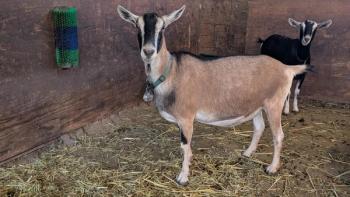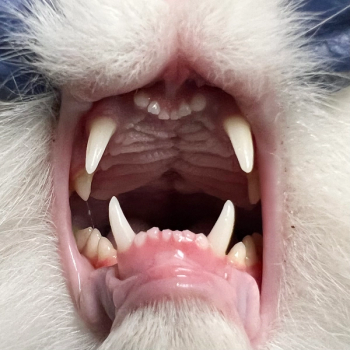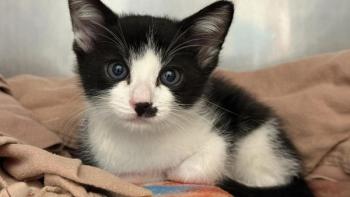
Clinical Exposures: A peritoneopericardial diaphragmatic hernia in a cat
An approximately 1-year-old, neutered male domestic longhaired cat weighing 6.5 lb (2.9 kg) was evaluated by the referring veterinarian because of mild dyspnea.
An approximately 1-year-old, neutered male, domestic longhaired cat weighing 6.5 lb (2.9 kg) was evaluated by the referring veterinarian because of mild dyspnea. About three months earlier, the cat had been adopted as a stray, and the referring veterinarian had treated it for a mild upper respiratory infection. Feline leukemia virus antigen and feline immunodeficiency virus antibody tests had been performed when the cat was adopted and then again six weeks later, and the results were negative each time. The cat had also received a broad-spectrum anthelmintic and had been neutered and vaccinated with no complications.
Physical examination and diagnostic tests
On physical examination, the cat's temperature was 101.3 F (38.5 C), heart rate was 160 beats/min, and respiratory rate was 36 breaths/min. The cat was small in stature and thin; the only other abnormality was slightly muffled heart sounds on the right side.
The referring veterinarian repeated the FeLV antigen and FIV antibody tests, and the results were negative. A complete blood count revealed a decreased hematocrit (23.6%; normal = 28% to 48%) and lymphocytosis (7.3 × 103 /μl; normal = 1.6 to 7 × 103/μl). The serum chemistry profile abnormalities were hyperphosphatemia (8.9 mg/dl; normal = 2.5 to 7.3 mg/dl), increased alkaline phosphatase (135 U/L; normal = 3 to 80 U/L) and alanine transaminase (396 U/L; normal = 15 to 75 U/L) activities, and a mildly decreased blood urea nitrogen concentration (14.6 mg/dl; normal = 15 to 33 mg/dl). Thyroxine concentrations were normal. Urinalysis revealed a mild increase in specific gravity (1.072; normal = 1.020 to 1.060), hematuria (319 RBCs/hpf; normal = 0 to 2 RBCs/hpf), and proteinuria (1+; normal = negative).
Figure 1A
Lateral and ventrodorsal thoracic radiographs revealed an enlarged cardiac silhouette (Figures 1A & 1B). Differential diagnoses included a peritoneopericardial diaphragmatic hernia, an endocardial cushion defect, congenital heart defects (e.g. patent ductus arteriosus, ventricular septal defects), cardiomyopathy, and pericardial effusion. No murmurs or lung abnormalities were auscultated, and the cat was not exhibiting any other clinical signs. Positive contrast peritoneography using 12 ml diatrizoate sodium was performed, and the lateral and ventrodorsal radiographs revealed contrast media in the abdominal cavity and surrounding the heart (Figures 2A & 2B). These results confirmed a diagnosis of peritoneopericardial diaphragmatic hernia.
Figure 1B
The decreased hematocrit, hyperphosphatemia, and increased alkaline phosphatase activity may have been related to the cat's age, and the mild lymphocytosis was consistent with an excited, young cat. The elevated alanine transaminase activity and decreased blood urea nitrogen concentration may have been related to hepatic inflammation associated with displacement. The hematuria may have been due to traumatic cystocentesis.
Figure 2A
The referring veterinarian also performed an abdominal ultrasonographic examination, and it revealed liver tissue adjacent to the heart, within the pericardium. The cat was referred to Veterinary Surgical Services for surgical correction of the peritoneopericardial diaphragmatic hernia.
Figure 2B
Surgical findings and treatment
The cat was premedicated with atropine (0.05 mg/kg) and butorphanol tartrate (0.22 mg/kg) subcutaneously. Cefazolin (22 mg/kg intravenously) was given prophylactically and was discontinued after surgery. Anesthesia was induced with ketamine hydrochloride (6.6 mg/kg) and diazepam (0.33 mg/kg) given intravenously. The cat was maintained on isoflurane throughout surgery, and manual ventilation was used to assist respiration during the procedure.
Figure 3
The cat was placed in dorsal recumbency, and a ventral midline celiotomy was performed. Parts of the right and left medial liver lobes, the quadrate lobe, and the gallbladder were lying in the pericardial sac through a vertical rent about 5 cm in length. This rent was in the central tendinous portion of the diaphragm (Figure 3). Manual manipulation of the liver within the pericardial sac revealed adhesions of the falciform ligament to the surface of the herniated liver lobes, but none to the heart or pericardial sac. The adhesions were broken down, the liver lobes and gallbladder were replaced into the abdominal cavity, and the rent was closed with 3-0 nylon suture in a Ford suture pattern. Air was removed from the pericardial sac with a 20-ga catheter placed through the diaphragm (Figure 4). The catheter was removed, and the abdomen was closed routinely. Dexamethasone sodium phosphate (0.5 mg/kg intravenously) was given because a portion of the liver was trapped in the pericardial sac and reperfusion injury was possible.
Figure 4
Recovery and follow-up
The cat received butorphanol (0.24 mg/kg subcutaneously) for postoperative analgesia. The cat began eating four hours after surgery and recovered well. It was discharged to the referring veterinarian that evening. Oral butorphanol (0.3 mg/kg b.i.d.) was given for pain relief for five days. No respiratory or cardiovascular problems were observed. The referring veterinarian removed the skin staples in 12 days, and a complete blood count and serum chemistry profile revealed no abnormalities. Thoracic radiographic findings obtained three months after surgery were normal. The cat gained weight and remains free of any clinical signs six months after surgery.
Discussion
Peritoneopericardial diaphragmatic hernia is due to faulty transverse septum development in the embryo.1-3 The transverse septum develops into the central tendon of the diaphragm. Peritoneopericardial diaphragmatic hernias have been reported in dogs, cats, rabbits, a donkey, and a calf.4 In dogs and cats, this condition is not due to a postnatal traumatic episode because, unlike in people, the peritoneal and pericardial cavities are not directly connected. No sex or breed predilection is reported,5 although in one study 4 of 13 dogs (31%) were Weimaraners and 9 of 34 cats (26%) were Persians.5,6 Peritoneopericardial diaphragmatic hernias are usually an incidental finding. No age predisposition is reported. These hernias have been found in dogs as early as 14 weeks old and as late as 10 years old; they've been seen in cats as early as 8 weeks old and as late as 14 years old.5,6 Other congenital anomalies such as hydrocephalus, umbilical hernias, sternal defects, cranial midline abdominal hernias, abnormal swirling of hair on the ventral abdomen, intracardiac defects, and pulmonary vascular disease can be seen in conjunction with peritoneopericardial diaphragmatic hernias.1,4-6
Peritoneopericardial diaphragmatic hernias are usually diagnosed by performing thoracic radiography, ultrasonography, and contrast radiography. These hernias are also incidental findings at necropsy. Common clinical signs may include respiratory signs such as dyspnea, tachypnea, coughing, or wheezing and gastrointestinal signs related to anorexia, polyphagia, vomiting, or diarrhea. Other signs include weight loss, abdominal pain, ascites, exercise intolerance, shock, and collapse.1,5,6
Peritoneopericardial diaphragmatic hernias are rare but should be included as a differential diagnosis in a cat with an enlarged cardiac silhouette. Surgical correction is the treatment of choice. Complications that arise are usually directly related to the organs that are herniated, such as myelolipomatous change of the herniated liver, portal hypertension, and reperfusion injuries.2 Also, adhesions to organs in the thoracic cavity can occur and complicate the surgery. The prognosis after surgical correction of the defect, in the absence of other complicating factors, is good for normal life expectancy.5,6
The photographs and information for this case were provided by Joshua F. Rexing, DVM, and Bradley R. Coolman, DVM, MS, DACVS, Veterinary Surgical Services, 5818 Maplecrest Road, Fort Wayne, IN 46835. Dr. Rexing's current address is Petsburgh, 2506 Schuyler Ave., Lafayette, IN 47905.
REFERENCES
1. Hunt, G.B.; Johnson, K.A.: Diaphragmatic, pericardial, and hiatal hernia. Textbook of Small Animal Surgery (D. Slatter, ed.). W.B. Saunders, Philadelphia, Pa., 2003; pp 471-485.
2. Frye, F.L.; Taylor, D.N.: Pericardial and diaphragmatic defects in the cat. JAVMA 152 (10):1507-1510; 1968.
3. Mims, J.P.; Mathis, P.D.: Diagnosing a peritoneopericardial hernia. Vet. Med. 79 (7):911-914; 1984.
4. Wright, R.P. et al.: Surgical repair of a congenital pericardial diaphragmatic hernia. Vet. Med.82 (6):618-624; 1987.
5. Evans, S.M.; Biery, D.O.N.: Congenital peritoneopericardial diaphragmatic hernia in the dog and cat: A literature review and 17 additional case histories. Vet. Radiol. 21:108-116; 1980.
6. Neiger, R.: Peritoneopericardial diaphragmatic hernia in cats. Compend. Cont. Ed. 18:461-478; 1996.
Newsletter
From exam room tips to practice management insights, get trusted veterinary news delivered straight to your inbox—subscribe to dvm360.






